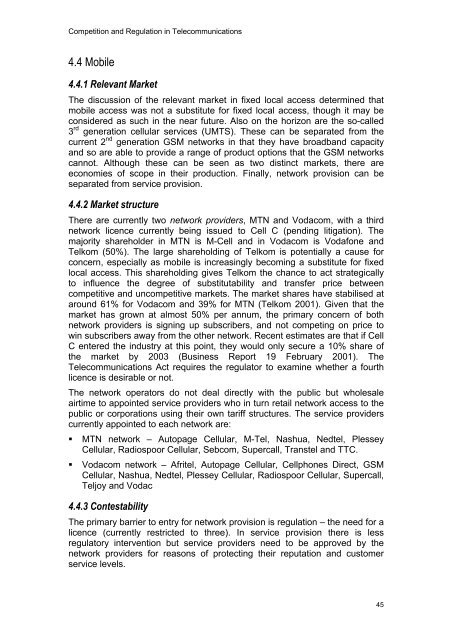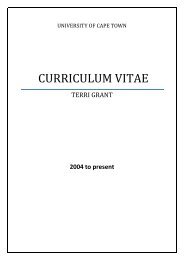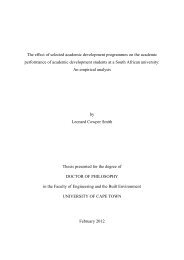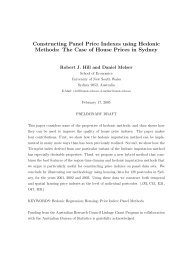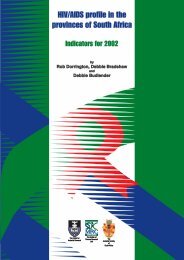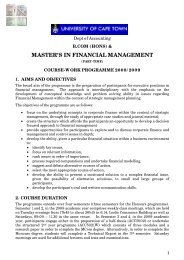Competition and Regulation in the Telecommunications Industry in ...
Competition and Regulation in the Telecommunications Industry in ...
Competition and Regulation in the Telecommunications Industry in ...
You also want an ePaper? Increase the reach of your titles
YUMPU automatically turns print PDFs into web optimized ePapers that Google loves.
<strong>Competition</strong> <strong>and</strong> <strong>Regulation</strong> <strong>in</strong> <strong>Telecommunications</strong>4.4 Mobile4.4.1 Relevant MarketThe discussion of <strong>the</strong> relevant market <strong>in</strong> fixed local access determ<strong>in</strong>ed thatmobile access was not a substitute for fixed local access, though it may beconsidered as such <strong>in</strong> <strong>the</strong> near future. Also on <strong>the</strong> horizon are <strong>the</strong> so-called3 rd generation cellular services (UMTS). These can be separated from <strong>the</strong>current 2 nd generation GSM networks <strong>in</strong> that <strong>the</strong>y have broadb<strong>and</strong> capacity<strong>and</strong> so are able to provide a range of product options that <strong>the</strong> GSM networkscannot. Although <strong>the</strong>se can be seen as two dist<strong>in</strong>ct markets, <strong>the</strong>re areeconomies of scope <strong>in</strong> <strong>the</strong>ir production. F<strong>in</strong>ally, network provision can beseparated from service provision.4.4.2 Market structureThere are currently two network providers, MTN <strong>and</strong> Vodacom, with a thirdnetwork licence currently be<strong>in</strong>g issued to Cell C (pend<strong>in</strong>g litigation). Themajority shareholder <strong>in</strong> MTN is M-Cell <strong>and</strong> <strong>in</strong> Vodacom is Vodafone <strong>and</strong>Telkom (50%). The large sharehold<strong>in</strong>g of Telkom is potentially a cause forconcern, especially as mobile is <strong>in</strong>creas<strong>in</strong>gly becom<strong>in</strong>g a substitute for fixedlocal access. This sharehold<strong>in</strong>g gives Telkom <strong>the</strong> chance to act strategicallyto <strong>in</strong>fluence <strong>the</strong> degree of substitutability <strong>and</strong> transfer price betweencompetitive <strong>and</strong> uncompetitive markets. The market shares have stabilised ataround 61% for Vodacom <strong>and</strong> 39% for MTN (Telkom 2001). Given that <strong>the</strong>market has grown at almost 50% per annum, <strong>the</strong> primary concern of bothnetwork providers is sign<strong>in</strong>g up subscribers, <strong>and</strong> not compet<strong>in</strong>g on price tow<strong>in</strong> subscribers away from <strong>the</strong> o<strong>the</strong>r network. Recent estimates are that if CellC entered <strong>the</strong> <strong>in</strong>dustry at this po<strong>in</strong>t, <strong>the</strong>y would only secure a 10% share of<strong>the</strong> market by 2003 (Bus<strong>in</strong>ess Report 19 February 2001). The<strong>Telecommunications</strong> Act requires <strong>the</strong> regulator to exam<strong>in</strong>e whe<strong>the</strong>r a fourthlicence is desirable or not.The network operators do not deal directly with <strong>the</strong> public but wholesaleairtime to appo<strong>in</strong>ted service providers who <strong>in</strong> turn retail network access to <strong>the</strong>public or corporations us<strong>in</strong>g <strong>the</strong>ir own tariff structures. The service providerscurrently appo<strong>in</strong>ted to each network are:• MTN network – Autopage Cellular, M-Tel, Nashua, Nedtel, PlesseyCellular, Radiospoor Cellular, Sebcom, Supercall, Transtel <strong>and</strong> TTC.• Vodacom network – Afritel, Autopage Cellular, Cellphones Direct, GSMCellular, Nashua, Nedtel, Plessey Cellular, Radiospoor Cellular, Supercall,Teljoy <strong>and</strong> Vodac4.4.3 ContestabilityThe primary barrier to entry for network provision is regulation – <strong>the</strong> need for alicence (currently restricted to three). In service provision <strong>the</strong>re is lessregulatory <strong>in</strong>tervention but service providers need to be approved by <strong>the</strong>network providers for reasons of protect<strong>in</strong>g <strong>the</strong>ir reputation <strong>and</strong> customerservice levels.45


